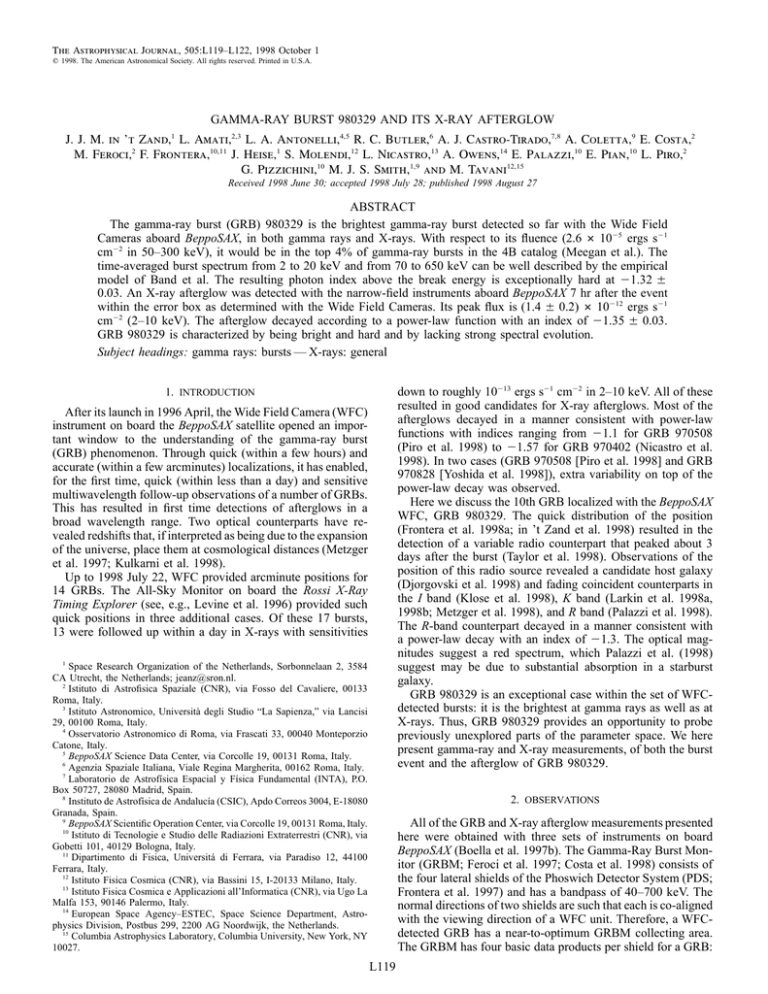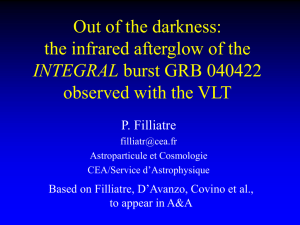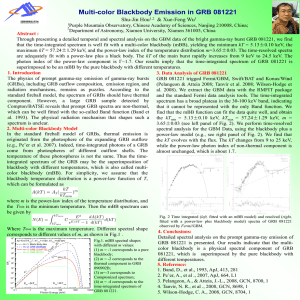
The Astrophysical Journal, 505:L119–L122, 1998 October 1
q 1998. The American Astronomical Society. All rights reserved. Printed in U.S.A.
GAMMA-RAY BURST 980329 AND ITS X-RAY AFTERGLOW
1
J. J. M. in ’t Zand, L. Amati,2,3 L. A. Antonelli,4,5 R. C. Butler,6 A. J. Castro-Tirado,7,8 A. Coletta,9 E. Costa,2
M. Feroci,2 F. Frontera,10,11 J. Heise,1 S. Molendi,12 L. Nicastro,13 A. Owens,14 E. Palazzi,10 E. Pian,10 L. Piro,2
G. Pizzichini,10 M. J. S. Smith,1,9 and M. Tavani12,15
Received 1998 June 30; accepted 1998 July 28; published 1998 August 27
ABSTRACT
The gamma-ray burst (GRB) 980329 is the brightest gamma-ray burst detected so far with the Wide Field
Cameras aboard BeppoSAX, in both gamma rays and X-rays. With respect to its fluence (2.6 # 1025 ergs s21
cm22 in 50–300 keV), it would be in the top 4% of gamma-ray bursts in the 4B catalog (Meegan et al.). The
time-averaged burst spectrum from 2 to 20 keV and from 70 to 650 keV can be well described by the empirical
model of Band et al. The resulting photon index above the break energy is exceptionally hard at 21.32 5
0.03. An X-ray afterglow was detected with the narrow-field instruments aboard BeppoSAX 7 hr after the event
within the error box as determined with the Wide Field Cameras. Its peak flux is (1.4 5 0.2) # 10212 ergs s21
cm22 (2–10 keV). The afterglow decayed according to a power-law function with an index of 21.35 5 0.03.
GRB 980329 is characterized by being bright and hard and by lacking strong spectral evolution.
Subject headings: gamma rays: bursts — X-rays: general
down to roughly 10213 ergs s21 cm22 in 2–10 keV. All of these
resulted in good candidates for X-ray afterglows. Most of the
afterglows decayed in a manner consistent with power-law
functions with indices ranging from 21.1 for GRB 970508
(Piro et al. 1998) to 21.57 for GRB 970402 (Nicastro et al.
1998). In two cases (GRB 970508 [Piro et al. 1998] and GRB
970828 [Yoshida et al. 1998]), extra variability on top of the
power-law decay was observed.
Here we discuss the 10th GRB localized with the BeppoSAX
WFC, GRB 980329. The quick distribution of the position
(Frontera et al. 1998a; in ’t Zand et al. 1998) resulted in the
detection of a variable radio counterpart that peaked about 3
days after the burst (Taylor et al. 1998). Observations of the
position of this radio source revealed a candidate host galaxy
(Djorgovski et al. 1998) and fading coincident counterparts in
the I band (Klose et al. 1998), K band (Larkin et al. 1998a,
1998b; Metzger et al. 1998), and R band (Palazzi et al. 1998).
The R-band counterpart decayed in a manner consistent with
a power-law decay with an index of 21.3. The optical magnitudes suggest a red spectrum, which Palazzi et al. (1998)
suggest may be due to substantial absorption in a starburst
galaxy.
GRB 980329 is an exceptional case within the set of WFCdetected bursts: it is the brightest at gamma rays as well as at
X-rays. Thus, GRB 980329 provides an opportunity to probe
previously unexplored parts of the parameter space. We here
present gamma-ray and X-ray measurements, of both the burst
event and the afterglow of GRB 980329.
1. INTRODUCTION
After its launch in 1996 April, the Wide Field Camera (WFC)
instrument on board the BeppoSAX satellite opened an important window to the understanding of the gamma-ray burst
(GRB) phenomenon. Through quick (within a few hours) and
accurate (within a few arcminutes) localizations, it has enabled,
for the first time, quick (within less than a day) and sensitive
multiwavelength follow-up observations of a number of GRBs.
This has resulted in first time detections of afterglows in a
broad wavelength range. Two optical counterparts have revealed redshifts that, if interpreted as being due to the expansion
of the universe, place them at cosmological distances (Metzger
et al. 1997; Kulkarni et al. 1998).
Up to 1998 July 22, WFC provided arcminute positions for
14 GRBs. The All-Sky Monitor on board the Rossi X-Ray
Timing Explorer (see, e.g., Levine et al. 1996) provided such
quick positions in three additional cases. Of these 17 bursts,
13 were followed up within a day in X-rays with sensitivities
1
Space Research Organization of the Netherlands, Sorbonnelaan 2, 3584
CA Utrecht, the Netherlands; jeanz@sron.nl.
2
Istituto di Astrofisica Spaziale (CNR), via Fosso del Cavaliere, 00133
Roma, Italy.
3
Istituto Astronomico, Università degli Studio “La Sapienza,” via Lancisi
29, 00100 Roma, Italy.
4
Osservatorio Astronomico di Roma, via Frascati 33, 00040 Monteporzio
Catone, Italy.
5
BeppoSAX Science Data Center, via Corcolle 19, 00131 Roma, Italy.
6
Agenzia Spaziale Italiana, Viale Regina Margherita, 00162 Roma, Italy.
7
Laboratorio de Astrofı́sica Espacial y Fı́sica Fundamental (INTA), P.O.
Box 50727, 28080 Madrid, Spain.
8
Instituto de Astrofı́sica de Andalucı́a (CSIC), Apdo Correos 3004, E-18080
Granada, Spain.
9
BeppoSAX Scientific Operation Center, via Corcolle 19, 00131 Roma, Italy.
10
Istituto di Tecnologie e Studio delle Radiazioni Extraterrestri (CNR), via
Gobetti 101, 40129 Bologna, Italy.
11
Dipartimento di Fisica, Universitá di Ferrara, via Paradiso 12, 44100
Ferrara, Italy.
12
Istituto Fisica Cosmica (CNR), via Bassini 15, I-20133 Milano, Italy.
13
Istituto Fisica Cosmica e Applicazioni all’Informatica (CNR), via Ugo La
Malfa 153, 90146 Palermo, Italy.
14
European Space Agency–ESTEC, Space Science Department, Astrophysics Division, Postbus 299, 2200 AG Noordwijk, the Netherlands.
15
Columbia Astrophysics Laboratory, Columbia University, New York, NY
10027.
2. OBSERVATIONS
All of the GRB and X-ray afterglow measurements presented
here were obtained with three sets of instruments on board
BeppoSAX (Boella et al. 1997b). The Gamma-Ray Burst Monitor (GRBM; Feroci et al. 1997; Costa et al. 1998) consists of
the four lateral shields of the Phoswich Detector System (PDS;
Frontera et al. 1997) and has a bandpass of 40–700 keV. The
normal directions of two shields are such that each is co-aligned
with the viewing direction of a WFC unit. Therefore, a WFCdetected GRB has a near-to-optimum GRBM collecting area.
The GRBM has four basic data products per shield for a GRB:
L119
L120
IN ’T ZAND ET AL.
a time history of the 40–700 keV intensity with a variable time
resolution of up to 0.48 ms, 1 s time histories in 40–700 keV
and in greater than 100 keV, and a 256-channel spectrum that
is accumulated every 128 s (independently phased from GRB
trigger times; 240 of these channels contain scientific data up
to 650 keV).
The WFC instrument (Jager et al. 1997) consists of two
coded aperture cameras, each with a field of view of 40 C #
40 C full width to zero response and an angular resolution of
about 59. The bandpass is 2–26 keV.
The narrow field instruments (NFIs) include two imaging
instruments that, when combined, are sensitive to 0.1–10 keV
photons: the low-energy and the medium-energy concentrator
spectrometer (LECS and MECS, respectively; see Parmar et
al. 1997 and Boella et al. 1997a, respectively). They both have
circular fields of view with diameters of 379 and 569. The other
two, nonimaging, NFIs are the PDS (13–300 keV) and the
high-pressure gas scintillation proportional counter (4–120
keV; Manzo et al. 1997).
GRB 980329 triggered the GRBM on 1998 March 29.15587
UT. The peak intensity is 6.6 # 10 3 counts s21 in 40–700 keV.
Simultaneously, the burst was detected in the WFC unit 2 at
an off-axis angle of 197. The peak intensity was about 6 Crab
units in 2–26 keV. This is the brightest burst seen with both
GRBM and WFC. Nevertheless, the statistical quality of the
WFC data is moderate because of the relatively large off-axis
angle. The X-ray counterpart to GRB 980329 was localized
with the WFC with an error circle radius of 39 (Frontera et al.
1998a). The burst also triggered BATSE on board the Compton
Gamma Ray Observatory (CGRO) (trigger 6665; Briggs et al.
1998) and was detected above 1 MeV with the COMPTEL
instrument on the CGRO.16
GRB 980329 was declared a target of opportunity for the
NFI, and a follow-up observation was started on March 29.4499
UT, 7 hr after the burst. The afterglow, 1SAX J0702.613850,
was quickly identified in the LECS and MECS (in ’t Zand et
al. 1998). The time span of the observation is 41.5 hr. An
interruption occurred between 21.2 and 27.5 hr after the start.
The total net exposure times are 25 ks for the LECS and 64
ks for the MECS.
3. ANALYSIS
3.1. Burst Event
The most intense part of the burst has similar durations in
X-rays and gamma rays (see Fig. 1). The full width at halfmaximum duration of the burst is, within 0.5 s, equal to 8.6 s
from 2 to 700 keV. The average burst duration versus photon
energy relation, as defined by Fenimore et al. (1995) for bright
bursts, predicts a timescale at 10 keV that is 2.5 times larger
than that at 100 keV. There is a soft tail in the WFC data that
is not easily discernible in Figure 1, but it shows up in binned
imaging data up until 90 s after the trigger (see Fig. 3 below).
Beyond 40 keV, the burst shows a moderate spectral evolution
with a softening trend. The photon index as derived from a
power-law fit to the two-channel 1 s GRBM data (Fig. 1c)
varies between 21.19 5 0.06 and 21.96 5 0.26. A Fourier
power spectrum of the high-time resolution data of the GRBM
shows no features between 3 and 64 Hz.
The 256-channel GRBM data of GRB 980329 permit a sen16
Connors, A., Barthelmy, S. D., Butterworth, P., Kippen, R. M., & Connaughton, V. 1998, GCN/GRO COMPTEL Burst Position Notices (http://
gcn.gsfc.nasa.gov/gcn/comptelpgrbs.html).
Vol. 505
Fig. 1.—Time history of the burst itself as seen with WFC and GRBM, at
a time resolution of (a) 1 s and (b) 0.25 s. Panel c refers to the the photon
index of a power-law function description of the GRBM two-channel data.
The horizontal dashed lines refer to the background levels in the raw count
rates. These are the averages as determined from the data beyond 90 s.
sitive spectral analysis. A 128 s accumulation interval ends 54
s after the burst trigger and covers most of the burst (see Fig.
1). We have analyzed this spectrum above 70 keV simultaneously with the 2–20 keV spectrum measured with the WFC
from 0 to 54 s (below 70 keV the response matrix of the GRBM
is not sufficiently well known; the same applies to the WFC
matrix above 20 keV). We employed the GRB spectral model
defined by Band et al. (1993) as
N(E) 5
exp (2E/E ), for E ≤ (a 2 b)E ,
{AE
BE ,
for E ≥ (a 2 b)E
a
0
0
b
(1)
0
(in units of photons s21 cm22 keV21), where E is the photon
energy and A and B are coupled normalization constants. A fit
of this model to the data (see Fig. 2) reveals a 5 20.6 5
0.2, b 5 21.32 5 0.03, and E 0 5 134 5 110 keV (x r2 5
1.07 for 140 degrees of freedom [dof]). A broken power-law
function fits the data just as well (with comparable power-law
indices). Since b is larger than 22, even in the time-resolved
data (see Fig. 1c), the peak of the nFn spectrum is beyond the
high-energy boundary of our data set. A single power-law
model with absorption that is due to cold matter of cosmic
abundances describes the data worse, with x r2 5 1.35 (141 dof).
The chance probability that x r2 is at least that high is 2 #
1023. Although the WFC and GRBM instruments have not yet
been cross-calibrated, we anticipate no large relative systematic
errors between the WFC and the GRBM. The WFC could be
No. 2, 1998
GRB 980329 AND ITS X-RAY AFTERGLOW
L121
Fig. 3.—Time history of the X-ray afterglow, based on WFC (first 3 data
points) and MECS data (last 5 points). The horizontal bars refer to the times
of observation; the vertical bars refer to the 1 j errors. The first point is from
15 to 23 s (see Fig. 1), which is the brightest part of the burst. The calibration
of MECS counts per second to 2–10 keV ergs s21 cm22 is based on the overall
LECS/MECS spectrum. The drawn line refers to a power-law fit to the data
(see text); the dashed line refers to an extrapolation.
Fig. 2.—The photon spectrum of GRB 980329 as measured with GRBM
between 274 and 54 s from the trigger time and with WFC between 0 and
54 s. The drawn line refers to the best-fit “Band” spectrum (see text).
calibrated for this particular observation with a standard calibration source (i.e., the Crab source) in the same field of view.
Furthermore, the GRBM was calibrated against the Crab source
and cross-calibrated against BATSE for a number of bursts.
Given the model spectrum, the fluence is (7 5 1) # 1027
ergs cm22 in 2–10 keV and (5.5 5 0.5) # 1025 ergs cm22 in
40–700 keV. The former fluence constitutes 1% of the expected
2–700 keV fluence. The 50–300 keV fluence of (2.6 5
0.3) # 1025 ergs cm22 would place GRB 980329 in the top
4% of the bursts in the 4B catalog (Meegan et al. 1998).
3.2. X-Ray Afterglow
The average LECS/MECS spectrum of 1SAX
J0702.613850 over the first 21 hr of the follow-up observation
(up until the interruption) could be modeled by a power-law
function with a photon index of G 5 22.4 5 0.4 and a lowenergy cutoff equivalent to interstellar absorption by a hydrogen column density of NH 5 (1.0 5 0.4) # 10 22 cm22 (x r2 5
0.9 for 28 dof). The 99% confidence interval for NH is
(0.21–2.3) # 10 22 cm22. A blackbody spectrum also fits the
data well; the parameters are kT 5 1.0 5 0.1 keV, NH !
2.4 # 10 22 cm22 (99% confidence level), and x r2 5 1.1 for 28
dof. An F-test does not rule out either spectral model. The
average flux is 4.0 # 10213 ergs s21 cm22 in 2–10 keV. The
predicted Galactic value for NH in the direction of the burst is
9 # 10 20 cm22 (interpolated from the maps by Dickey & Lockman 1990). This is inconsistent with the NFI result on NH for
the power-law model. The value of 1.9 # 10 21 cm22, as implied
by the reddening of the optical spectrum (Palazzi et al. 1998),
is marginally consistent with this value (the chance probability
for two NH values being at least as deviant as observed is 0.3%).
The data do not allow a sensitive timing analysis of the spectrum. The roughest such analysis reveals that the 3–10 keV
over 2–3 keV hardness ratio changes from 1.0 5 0.2 to
0.5 5 0.2 over the two halves of the observation. This is statistically consistent with a constant ratio.
The 13–300 keV PDS data of the first 21 hr of the followup observation show no detection of the afterglow. Assuming
that the same model spectrum applies as to the LECS and
MECS data, the 3 j upper limit is 4 # 10211 ergs s21 cm22.
This is 2 orders of magnitude above the extrapolation of the
LECS/MECS spectrum into the PDS bandpass.
A time history of the afterglow was constructed from all the
MECS data for the 2–10 keV bandpass (see Fig. 3). The time
bins were scaled logarithmically in order to optimize the signalto-noise ratio in each bin. A power-law function satisfactorily
describes the data, the resulting power-law index is 21.5 5
0.2, and x r2 5 0.8 (3 dof). The trend in the afterglow extends
quite close to the WFC measurements of the burst (see Fig.
3). Therefore, in a next step, we included the 2–10 keV flux
as measured with WFC between 54 and 90 s after the trigger
into the model. The best-fit decay index is then 21.35 5
0.03 (x r2 5 0.8 for 4 dof). It is consistent with the index as
determined from the afterglow alone. We conclude that there
is evidence that the afterglow emission started during the tail
of the burst event. Unfortunately, we cannot substantiate this
with spectral measurements because of insufficient statistics.
There is WFC coverage from 24 hr before to about 5 hr after
the burst, with intermissions. No emission was detected from
the burst position outside the 90 s interval after the trigger time.
The 3 j upper limits are 1 # 10210 ergs s21 cm22 for the preburst data and 3 # 10210 ergs s21 cm22 for the postburst data
(2–10 keV).
Greiner et al. (1998) reported a ROSAT observation that
started 35 hr after the end of the NFI observation and lasted
L122
IN ’T ZAND ET AL.
39 hr (J. Greiner 1998, private communication). No X-ray afterglow was detected. For NH 5 1 # 10 22 cm22, the ROSAT
upper limit in 0.1–2.4 keV for the unabsorbed flux is 3 times
the value predicted from an extrapolation of the MECS
evolution.
The decay function predicts a 2–10 keV fluence (i.e., integrated from 1 s after the trigger onward) of 3 # 1026 ergs
cm22. In the 2–700 keV band, the afterglow fluence is 1 order
of magnitude smaller than the fluence of the burst event. The
decay index is consistent with that of the R-band counterpart
(Palazzi et al. 1998). Also, it is very close to the average of
21.32 over the X-ray afterglows of GRB 970228 (Costa et al.
1997), GRB 970402 (Nicastro et al. 1998), GRB 970508 (Piro
et al. 1998), GRB 970828 (Yoshida et al. 1998), and GRB
971214 (Heise et al. 1998).
No flares or dips occur on timescales down to 103 s. The
3 j upper limit, on upward fluctuations on a 4000 s timescale,
is 70% at the start and 240% at the end of the NFI observation.
The data are marginally sensitive to detecting flux increases
like those in GRB 970508 (about 200%; Piro et al. 1998) or
GRB 970828 (about 100%; Yoshida et al. 1998).
4. DISCUSSION
The spectrum of the burst is exceptionally hard above the
break energy during the whole event. Preece et al. (1998) studied the spectra of 126 bright bursts that were detected above
28 keV with the BATSE during 1991–1997, with fluences comparable to or higher than that of GRB 980329. None of these
bursts show a time-averaged b 1 21.51. Another study of 22
GRBs, detected with GRB sensors on board Ginga in the 2–400
keV range, shows a similar upper boundary of 21.50 (Strohmayer et al. 1998). Our results indicate that in rare cases, the
radiative conditions applicable to high peak intensity bursts can
favor hard power-law components in the spectrum.
Of all the 14 GRBs detected with the WFC and GRBM,
GRB 980329 is the brightest in both X-rays and gamma rays.
The burst most similar to GRB 980329 is GRB 970111 (Feroci
et al. 1998). It has a similar ratio of the GRBM to the WFC
photon count rate during the gamma-ray peak, and its gamma-
Vol. 505
ray peak intensity and fluence are only ∼20% smaller. Furthermore, the durations of both bursts are similar, and the
gamma-ray time profiles are, to the eye, of the same complexity.
The difference between both bursts is that the time profile of
GRB 970111 shows much more spectral evolution and is softer
at high energies, as indicated by the average for b of
22.13 5 0.03 (Frontera et al. 1998b).
The behavior of the X-ray afterglow of GRB 980329 is quite
similar to that of afterglows of other GRBs, in both intensity
and decay index (except for GRB 970228, which is brighter).
Therefore, in general, there does not appear to be a strong
correlation between burst events and their X-ray afterglow.
GRB afterglow observations generally comply well with the
relativistic blast-wave model in which relativistic electrons produce synchrotron radiation (see, e.g., Wijers, Rees, & Meszáros
1997; Sari, Piran, & Narayan 1998). In this model, the spectral
evolution is given by F(n, t) ∝ t dn e for a range of frequencies
and times that contain no spectral breaks. In each of the two
states, d and e are functions of only p, the power-law exponent
of the electron Lorentz factor distribution. For the synchrotron
cooling stage of the blast wave, e s 5 2d/3. For the adiabatic
cooling stage, ea 5 (2d/3) 2 (1/3). For d 5 21.35 5 0.03,
e s 5 20.90 5 0.02, and ea 5 21.23 5 0.02. The measured
value of e 5 21.4 5 0.4 complies well to both predictions,
with a weak preference for adiabatic cooling for which p 5
(24d 1 2)/3 5 2.46 5 0.04.
The brightness of the burst suggests the possibility of a relatively small distance. However, beaming effects may be important and may be related to the lack of a strong spectral
evolution of the burst and the relative hardness at high energies.
A future redhift measurement of the proposed host galaxy
(Djorgovski et al. 1998) and a continued monitoring of the
radio scintillation (Taylor et al. 1998) may reveal more insight.
We are grateful to the staff of the BeppoSAX Scientific Operation Center, the Mission Planning Team, and the Science
Data Center for their support in obtaining and processing the
data. The BeppoSAX satellite is a joint Italian and Dutch
program.
REFERENCES
Band, D., et al. 1993, ApJ, 413, 281
Boella, G., Butler, R. C., Perola, G. C., Piro, L., Scarsi, L., & Bleeker,
J. A. M. 1997a, A&AS, 122, 299
Boella, G., et al. 1997b, A&AS, 122, 327
Briggs, M., Richardson, G., Kippen, R. M., & Woods, P. M. 1998, IAU Circ.
6856
Costa, E., et al. 1997, Nature, 387, 783
———. 1998, Adv. Space Res., in press
Dickey, J. M., & Lockman, F. J. 1990, ARA&A, 28, 215
Djorgovski, S. G., et al. 1998, GCN Circ. 41
Fenimore, E. E., in ’t Zand, J. J. M., Norris, J. P., Bonnell, J. T., & Nemiroff,
R. J. 1995, ApJ, 448, L101
Feroci, M., et al. 1997, Proc. SPIE, 3114, 186
———. 1998, A&A, 332, L29
Frontera, F., et al. 1997, A&AS, 122, 357
———. 1998a, IAU Circ. 6853
———. 1998b, in AIP Conf. Proc. 428, Gamma-Ray Bursts, ed. C. A. Meegan,
R. D. Preece, & T. M. Koshut (New York: AIP), 446
Greiner, J., et al. 1998, GCN Circ. 59
Heise, J., et al. 1998, in preparation
in ’t Zand, J. J. M., et al. 1998, IAU Circ. 6854
Jager, R., et al. 1997, A&AS, 125, 557
Klose, S., et al. 1998, GCN Circ. 43
Kulkarni, S. R., et al. 1998, Nature, 393, 35
Larkin, J., et al. 1998a, GCN Circ. 44
———. 1998b, GCN Circ. 51
Levine, A. M., et al. 1996, ApJ, 467, L33
Manzo, G., et al. 1997, A&AS, 122, 341
Meegan, C., et al. 1998, in AIP Conf. Proc. 428, Gamma-Ray Bursts, ed.
C. A. Meegan, R. D. Preece, & T. M. Koshut (New York: AIP), 3
Metzger, M. R., et al. 1997, Nature, 387, 879
———. 1998, GCN Circ. 55
Nicastro, L., et al. 1998, A&A, submitted
Palazzi, E., et al. 1998, A&A, 336, L95
Parmar, A. N., et al. 1997, A&AS, 122, 309
Piro, L., et al. 1998, A&A, 331, L41
Preece, R. D., et al. 1998, ApJ, 496, 849
Sari, R., Piran, T., & Narayan, R. 1998, ApJ, 497, L17
Strohmayer, T. E., Fenimore, E. E., Murakami, T., & Yoshida, A. 1998, ApJ,
500, 873
Taylor, G. B., et al. 1998, ApJ, 502, L115
Yoshida, A., et al. 1998, in AIP Conf. Proc. 428, Gamma-Ray Bursts, ed.
C. A. Meegan, R. D. Preece, & T. M. Koshut (New York: AIP), 441
Wijers, R. A. M. J., Rees, M. J., & Meszáros, P. 1997, MNRAS, 288, L51




